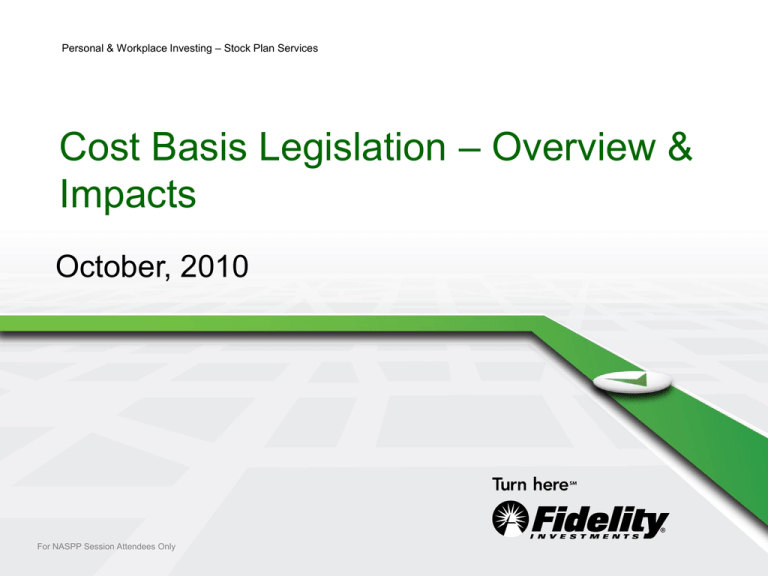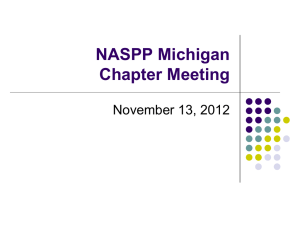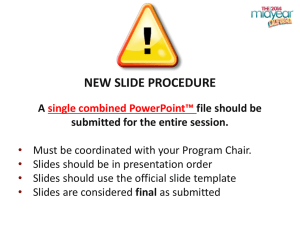Cost Basis Legislation Overview
advertisement

Personal & Workplace Investing – Stock Plan Services Cost Basis Legislation – Overview & Impacts October, 2010 For NASPP Session Attendees Only Cost Basis Legislation – Background The Cost Basis Legislation (CBL) was passed on October 3rd of 2008 as part of the Emergency Economic Stabilization Act GAO estimated tax payers have been under reporting capital gains by $11 Billion IRS issued draft regulations in December 2009, final regulations on October 12th with an effective date of October 18, 2010 Record keepers will be responsible for maintaining and transferring cost basis information Broker dealers will be responsible to report cost basis data at sale to investors and the IRS on the Form 1099-B Effective Dates – Securities are considered to be covered and therefore eligible for basis reporting based on their acquisition date and security classification: 1/1/2011: Stock in a Corporation (including shares acquired through an Equity Compensation arrangement) 1/1/2012: Securities Eligible for Average Cost (RIC or Mutual Funds and DRIP) 1/1/2013: Option Reporting and all Other Securities as determined by the IRS Penalties for incorrect reporting will be significant for non-compliance – however the IRS has granted penalty relief for brokers and custodians for reporting certain transfers of stock in 2011 2 Penalty of $100 per incorrect form 1099-B sent to the investor, and $50 for incorrect form sent to the IRS; Maximum up to $350,000 For NASPP Session Attendees Only Calculating Cost Basis Source: TowerGroup “Cost Basis Technology for Broker Dealers” 3 For NASPP Session Attendees Only Industry Coverage Securities Industry and Financial Markets Association (SIFMA) Financial Information Forum (FIF) Depository Trust & Clearing Corporation (DTCC) Cost Basis Reporting System (CBRS) Steering Committee Investment Company Institute (ICI) Broker/Dealer Advisory Committee (BDAC) CBR Task Force ICI Tax Committee 4 Transfer Agency Advisory Committee (TAAC) CBR Task Force For NASPP Session Attendees Only Brokerage Impacts – 2011, 2012 & 2013 2011 • Covered Security Identification • Multiple Lot Relief Methods • Adjusted Cost Basis • 1099B Reporting • Gifts • Transfers & Client Conversions • Customer Provided Basis 5 For NASPP Session Attendees Only 2012 • Mutual Funds (RIC) • Corporate Reporting • DRPs • Short Sale Withholding 2013 • All Other Securities (including Options & Bonds) 2011 Impacts – Equity Compensation Plans Cost basis is established when ownership of any stock-settled security is transferred to the employee Equity Compensation transactions that create a tax lot include: SOP Exercise and Sell, Exercise and Hold, Stock Swap SAR Exercise ESPP Purchase Stock not acquired for “cash” is excluded at this time, no penalty for over-reporting: RSA Vesting RSU / Performance Award Distribution Adjusted Cost Basis – ordinary income adjustments for ESPP & ISO dispositions (see 2013 impacts) 6 For NASPP Session Attendees Only 2013 Impacts – Equity Compensation Plans Adjusted Cost Basis – from draft IRS regulations; clarified in final regulations: (6) Adjusted basis--(i) In general. For purposes of this section, the adjusted basis of a security is determined from the basis determined under paragraph (d)(6)(ii) of this section as of the date the security is acquired in an account, increased by the commissions and transfer taxes related to its sale to the extent not accounted for in gross proceeds as described in paragraph (d)(5) of this section. When reporting adjusted basis, a broker must take into account organizational actions affecting the basis of the security if reported on any issuer statement (as described in §1.6045B1) but is not otherwise required to consider transactions, elections, or events occurring outside the account. (ii) Initial basis--(A) Cost basis. For a security acquired through a sale transaction in an account, the initial basis is the total amount paid by the customer or credited against the customer’s account for the security, increased by the commissions and transfer taxes related to its acquisition to the extent not accounted for in gross proceeds as described in paragraph (d)(5) of this section. For securities purchased or acquired pursuant to the exercise of an option granted or acquired before January 1, 2013, a broker may, but is not required to, take option premiums into account in determining the adjusted basis of the securities purchased or acquired pursuant to the exercise of the option. A broker may, but is not required to, take into account income recognized upon the exercise of a compensatory option or other equity-based compensation arrangement before January 1, 2013, in determining adjusted basis. Ordinary Income Adjustments: ISO qualifying disposition: cost basis is exercise price ISO & ESPP disqualifying disposition: report cost basis as capital gain + ordinary income ESPP qualifying disposition: report cost basis as lesser of (1) sales price -purchase price or (2) beginning offering period FMV x discount percentage 7 For NASPP Session Attendees Only Appendix For NASPP Session Attendees Only Draft Form 1099-B For illustrative purposes only 9 For NASPP Session Attendees Only NASPP and Fidelity Investments are not affiliated Fidelity Brokerage Services LLC, Member NYSE, SIPC Fidelity Stock Plan Services LLC 560235.2.0 For NASPP Session Attendees Only





![SEM_1_-_2.03-2.04_and_2.06_PPT[1]](http://s2.studylib.net/store/data/005412429_2-ee09ccc3ae8bb5a8455b0fdbcc5543ae-300x300.png)


